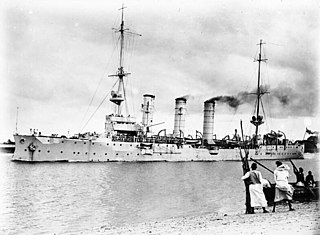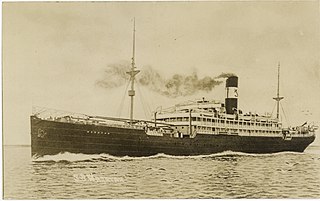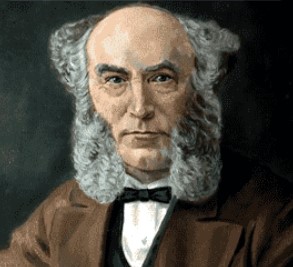Related Research Articles

SMS Königsberg was the lead ship of her class of light cruisers built by the German Kaiserliche Marine. Named after Königsberg, the capital of East Prussia, she was laid down in January 1905, launched in December of that year and completed by June 1906. Her class included three other ships: Stettin, Stuttgart, and Nürnberg. Königsberg was armed with a main battery of ten 10.5-centimeter (4.1 in) guns and had a top speed of 24.1 knots.

SS Waratah was a passenger and cargo steamship built in 1908 for the Blue Anchor Line to operate between Europe and Australia. In July 1909, on only her second voyage, the ship, en route from Durban to Cape Town, disappeared with 211 passengers and crew aboard. No trace of the ship has ever been found.
USS Anacostia (1856) was a steamer, constructed as a tugboat, that was first chartered by the United States Navy for service during the Paraguay crisis of the 1850s and then commissioned as a U.S. Navy ship. She later served prominently in the Union Navy during the American Civil War.
German submarine U-177 was a Type IXD2 U-boat of Nazi Germany's Kriegsmarine during World War II. The submarine was laid down on 25 November 1940, at the DeSchiMAG AG Weser yard in Bremen, as yard number 1017. She was launched on 1 October 1941, and commissioned on 14 March 1942, under the command of Kapitänleutnant Wilhelm Schulze. After a period of training with the 4th U-boat Flotilla at Stettin, the boat was transferred to the 10th flotilla on 1 October 1942, and based at Lorient, for front-line service, she was then reassigned to the 12th flotilla at Bordeaux on 1 December.
33°23′00″S27°19′33″E
Inkosi was a 6,618 GRT refrigerated cargo liner which was built by Swan, Hunter & Wigham Richardson Ltd, Newcastle upon Tyne for the Ministry of War Transport (MoWT). She was hired by the Royal Navy in 1940 for use as an ocean boarding vessel, but was sunk in an air raid before she could be used for this purpose. The ship was salvaged, converted to a cargo ship and passed to the Ministry of War Transport (MoWT), who renamed her Empire Chivalry. In 1946 she was sold and renamed Planter. She served until 1958, when she was scrapped.

Frontier was a 1,000 GRT cargo ship that was built in 1922 as Cattaro by Memeler Schiffswerke, Lindenau & Co, Memel, Germany. After a sale in 1930 she was renamed Finkenau. In 1945, she was renamed Levensau and was seized later that year by the Allies at Brunsbüttel, passed to the Ministry of War Transport (MoWT) and was renamed Empire Convoy. She was allocated to the Netherlands in 1946 and renamed Grebburg. She was sold into merchant service in 1947 and renamed Echo. A sale to South Africa in 1952 saw her renamed Frontier. The ship served until 1957 when she ran aground and broke up.

The Nimbin was a steel screw steamer built in 1927 at Copenhagen, that was the first motor vessel placed into the New South Wales coastal trade. It was owned and operated by the North Coast Steam Navigation Company and was the first Australian registered merchant ship to be lost during World War II when it struck a mine laid by the German auxiliary cruiser Pinguin. The Nimbin was on its way from Coffs Harbour to its home port, Sydney, with a cargo of bundled three-ply timber and a cargo of pigs. One third of the ship was blown away and it sank in three minutes. Seven men were killed. The remaining thirteen clung to bundles of plywood. Some hours later an air force plane from RAAF Base Rathmines saw the survivors and directed the coastal ship SS Bonalbo to the scene to retrieve them.
The California Steam Navigation Company was formed in 1854 to consolidate competing steamship companies in the San Francisco Bay Area and on the Sacramento and San Joaquin Rivers. It was successful in this effort and established a profitable near-monopoly which it maintained by buying out or bankrupting new competitors. In response to the Fraser Canyon gold rush and economic growth in the Pacific Northwest, the company expanded to ocean routes from San Francisco north to British Columbia. Similarly, as California's economy grew, the company offered service from San Francisco south to San Pedro and San Diego. It exited these markets in 1867 when competition drove prices to unprofitable levels. While the California Steam Navigation Company was successful throughout its life in suppressing steamboat competition on its core Bay Area and river routes, it could not control the rise of railroads. These new competitors reduced the company's revenue and profit. Finally, in 1871, the company's assets were purchased by the California Pacific Railroad, and the corporation was dissolved.
SS Gasfire was a British steam collier of the Gas Light and Coke Company (GLCC). She was built in Sunderland in 1936, survived severe damage from being torpedoed in 1940 and was sunk by a mine in the North Sea in 1941.

Corvus was a steam cargo ship built in 1919 by Columbia River Shipbuilding Company of Portland for the United States Shipping Board as part of the wartime shipbuilding program of the Emergency Fleet Corporation (EFC) to restore the nation's Merchant Marine. The freighter was operated on international and domestic routes through 1944. Early in 1945 she was transferred to Soviet Union as part of lend-lease program. After several months of operation, the freighter was rammed by another vessel on 31 May 1945 and was beached to avoid sinking. She was subsequently raised and towed to Portland where she was scrapped in 1946.
SS Oakland was a small general cargo/passenger ship commissioned in 1890, Dumbarton, Scotland, for New South Wales, Australia, timber merchant William T Yeager. It sank off Cabbage Tree Island, New South Wales, in 1903, with the loss of 11 lives.

Langton Grange was a refrigerated steam cargo ship built in 1896 by the Workman, Clark & Co. of Belfast for Houlder Brothers & Co. of London to transport meat and other produce from Australia and South America to United Kingdom.

John Thomson Rennie (1824-1878) was a Scottish ship-owner who played an important role in the South African shipping business from the mid-nineteenth century, carrying mail, cattle, and passengers. Two of his steamers were sunk in accidents not long after he received them but he continued in business with other ships.

The Madagascar was a ship of the Rennie line that was lost in 1858 after she hit a reef near the mouth of the Birha River, south of East London, in South Africa, around midnight on 3 December. Attempts to keep the ship afloat failed and she was run aground on the 4th and broke up. No lives were lost.
The Waldensian was a steamship of the Rennie line that was lost on 13 October 1862 after it ran aground on rocks at Struis Point near Cape Agulhas en route from Durban to Cape Town. The passengers included eight predikants of the Dutch Reformed Church, one of them, the reverend Frans L. Cachet, later writing that it was said on leaving Durban that the ship would not arrive safely, as "one minister aboard a ship is bad enough, but with eight on board, things could not possibly go well." There was no loss of life.

The Umgeni was a sailing ship of the Rennie line. She was launched in 1864 and served as a passenger ship transporting colonists to Natal before being converted to a coal carrier. In 1876 she ran aground near Glenelg in South Australia but was re-floated.
The Transvaal was a wooden barque cargo ship of the Rennie line. In December 1874 on her maiden voyage from London she dragged anchor and was driven ashore south of the Umgeni River in South Africa, causing 12 deaths.
Anglo-African was a steam cargo ship built in 1900 by the Short Brothers of Sunderland for Lawther, Latta & Co. of London with intention of operating on their Australian routes. The vessel operated mostly on South America to North America route during her career and was wrecked on one of her regular voyages in January 1909.
References
- ↑ Madagascar. Scottish Built Ships. Retrieved 6 May 2019.
- ↑ "Rennie's Steamer Service: Natal and Cape Colonies", R. N. Porter, The South African Philatelist, Vol. 90, No. 6 (December 2014), Whole No. 927, pp. 178-182.
- ↑ "Loss of the Steamer Madagascar", The Hobart Town Daily Mercury, 3 February 1859, p. 2. Retrieved from Trove, 6 May 2019.
Coordinates: 33°22′35″S27°19′25″E / 33.37639°S 27.32361°E